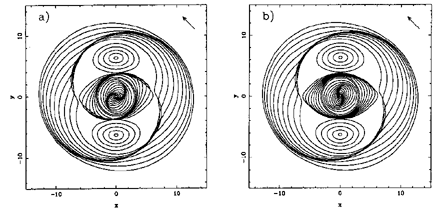


12.4. Fueling the Nucleus
Gravity torques from the bar can drive very efficiently the gas towards the center, and it has been proposed that non-axisymmetric potentials are the main agent to bring gas towards active nuclei, to fuel their strong energetic activity (Simkin et al. 1980). However, as emphasized by Combes & Gerin (1985), the gas is in general efficiently driven to the inner Lindblad resonance, where it accumulates, but not to the very center. We can try to understand schematically, in terms of orbits, the sense of winding of gaseous spiral arms in the center, and consequently the sense of gravity torques.
In a cos 2 bar potential,
the main families of periodic orbits
are aligned or anti-aligned to the bar, according to the position with
respect to Lindblad resonances (see
Figure 78). Due to cloud
collisions, the gas component cannot follow these periodic orbits;
instead, upon losing energy, the gas streams in elliptical trajectories
at lower and lower radii, with their major axes leading more and more
the periodic orbit, since the precession rate (estimated by
bar potential,
the main families of periodic orbits
are aligned or anti-aligned to the bar, according to the position with
respect to Lindblad resonances (see
Figure 78). Due to cloud
collisions, the gas component cannot follow these periodic orbits;
instead, upon losing energy, the gas streams in elliptical trajectories
at lower and lower radii, with their major axes leading more and more
the periodic orbit, since the precession rate (estimated by  -
-  / 2 in the axisymmetric
limit, for orbits near
ILR, and by
/ 2 in the axisymmetric
limit, for orbits near
ILR, and by  +
+  / 2 near OLR) increases with
decreasing radii
in most of the disk. This regular shift forces the gas into a trailing
spiral structure, from which the sense of the gravity torques can be
easily derived. Inside corotation, the torques are negative, and the
gas is driven inwards towards the inner Lindblad resonance (ILR).
Inside ILR, and from the center, the precessing rate is increasing with
radius, so that the gas pattern due to collisions will be a leading
spiral, instead of a trailing one (see
Figure 79). The gravity
torques are positive, which also contributes to the accumulation of gas
at the ILR ring. This situation is only inverted in the case of a
central mass concentration (a black hole?), for which the precession
rate
/ 2 near OLR) increases with
decreasing radii
in most of the disk. This regular shift forces the gas into a trailing
spiral structure, from which the sense of the gravity torques can be
easily derived. Inside corotation, the torques are negative, and the
gas is driven inwards towards the inner Lindblad resonance (ILR).
Inside ILR, and from the center, the precessing rate is increasing with
radius, so that the gas pattern due to collisions will be a leading
spiral, instead of a trailing one (see
Figure 79). The gravity
torques are positive, which also contributes to the accumulation of gas
at the ILR ring. This situation is only inverted in the case of a
central mass concentration (a black hole?), for which the precession
rate  -
-  / 2 is monotonically
increasing towards infinity
with decreasing radii. Only then, the gravity torques will pull the gas
towards the very center, and ``fuel'' the nucleus.
/ 2 is monotonically
increasing towards infinity
with decreasing radii. Only then, the gravity torques will pull the gas
towards the very center, and ``fuel'' the nucleus.

|
What can form the active nucleus in the first place? It will be shown in the following sections that the accumulation of matter towards the center can produce a decoupling of a second bar inside the primary bar. This nuclear bar, and possibly other ones nested inside like Russian dolls, can take over the action of gravity torques to drive the gas to the nucleus, as first proposed by Shlosman et al. (1989).